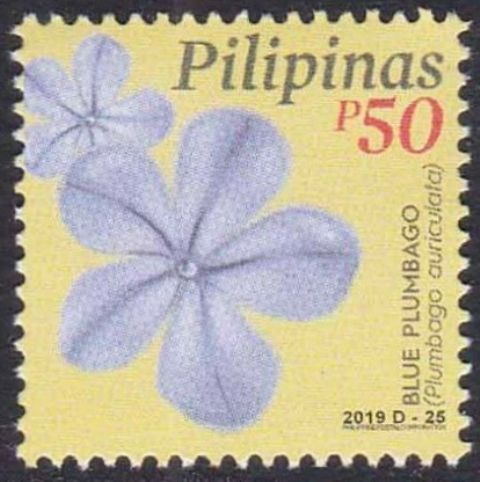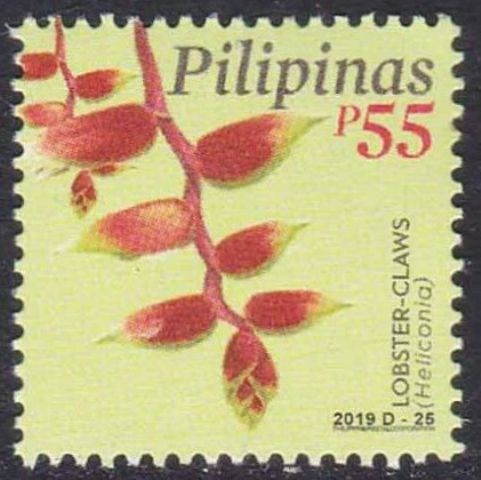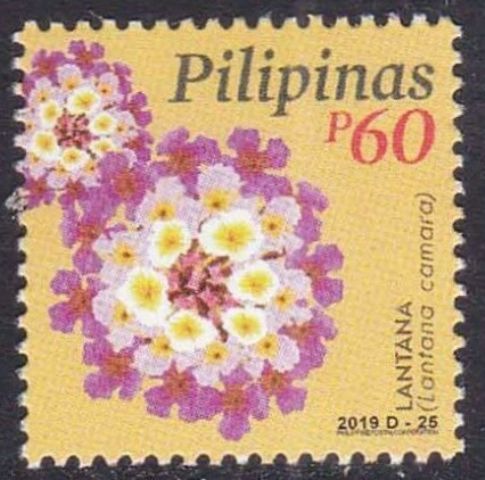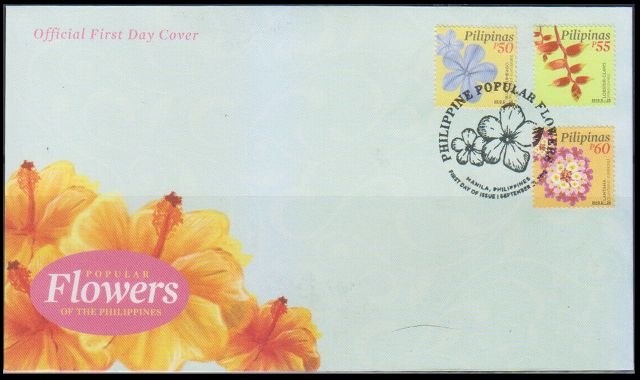2019, August 28. Popular Flowers of the Philippines, Series 5
Litho Offset, Amstar Printing Company, Inc., Perf 14
Singles, Sheets of 100



50p Blue Plumbago (Plumbago auriculata) - (1,250,000)
55p Lobster-Claws (Heliconia) - (2,000,000)
60p Lantana (Lantana camara) - (750,000)
Graphic Artist: Rodine C. Teodoro
First Day Covers: Manila
Popular Flowers of the Philippines, Definitives, Series 5
50p – Blue Plumbago (Plumbago Auriculata). The genus Plumbago comprises 10 species from the warm climate parts of the world. Etymologically, the name derives from plumbum, meaning lead, referring to its use for lead poisoning. Auriculata means ear-shaped, referring to the leaf base. Plumbago auriculata is a semi-climbing, diffusely branched perennial shrub, growing to 2 meters. Leaves are alternate, simple, entire, oblong or oblong-spatulate, up to 5 centimeters long, with the base tapering to a short petiole. Flowers are short spikelike racemes; calyx is tubular, shorter than the slender corolla. Corolla tube measures 2 to 2.5 centimeters long, five-lobed, azure blue and spreading. Fruit is a capsule that splits into five parts. Cultivated in gardens in towns and urban-suburban areas. Used as border plant, ornamental hedge, or ground cover.
http://www.stuartxchange.org/Plumbago.html55p – Lobster-Claws (Heliconia). Heliconia, also popularly known as lobster-claw, wild plantain or false bird-of-paradise, is a beautiful flower with multi-color bracts and varied flower structure. Heliconias are native to the tropical Americas and the Pacific Ocean islands west to Indonesia. Heliconias are one of the most colorful and beautiful flowers, the colors of which are an important source of attraction for the forest hummingbirds, pollinating the flowers. Heliconias are grown for their beautiful, brilliant colorful flowering bracts. Breathtaking and unusual flower heads (bracts) rise from clumps of banana like leaves, sometimes very large or slender. Heliconia flowers are actually highly modified leaves and bracts. The flowering stems are mostly pendulous. A bract is a leaf structure at the base of a flower. Heliconia flowers are produced on long, erect or drooping panicles, and consist of brightly colored waxy bracts, with small true flowers inside the bracts. Bracts which can be orange, purple, red, yellow, pink, green, or their combinations. https://www.theflowerexpert.com/content/aboutflowers/exoticflowers/heliconia
60p – Lantana (Lantana Camara). There are 40 species of the genus Lantana. Some are extremely unpleasant and toxic to livestock. In some countries, they are considered an invasive weed, earning the name, "Jekyll and Hyde of plants." It releases chemicals in its surroundings, preventing germination of the native flora. It is wont to form dense thickets, spreads very quickly, with one plant producing as many as 12,000 seeds a year. Branches are four-sided with re-curved prickles. Leaves are elliptic, 5 to 9 centimeters long, 3 inches long, pointed at the tip and rounded at the base and toothed in the margins. Flowers are pink, orange, yellow, white, lilac and other shades. A gregarious weed in the Philippines, in settled areas in thickets and waste places at low and medium altitudes. Certain varieties are cultivated as a trimmed hedge either alone or with other shrubs. http://www.stuartxchange.org/Kantutay
-
Flowers
